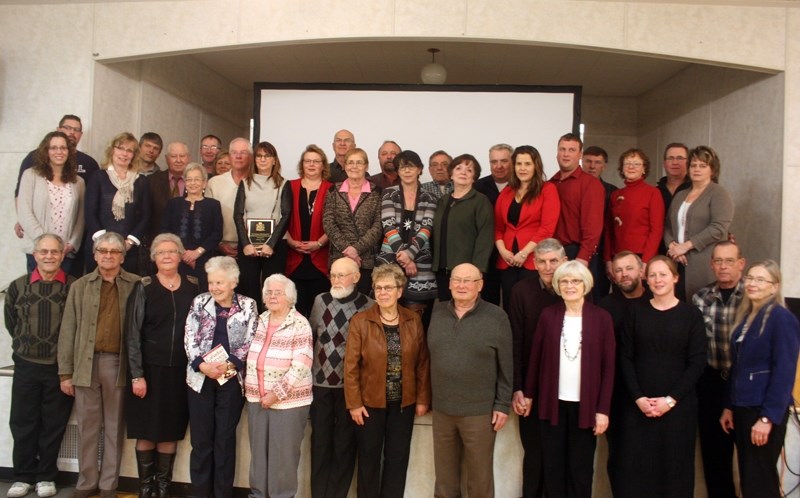“Ladies and gentlemen, a speaker I am not.”
That is how Walter Schmidt, the recipient of the ATB GROWTH Business of Excellence award and guest speaker of the Agriculture Service Board’s appreciation dinner, began his speech as part of the Agriculture Service Board’s Appreciation Dinner at the Summerdale Hall on Thursday, Jan. 7.
“I started out feeding cattle in 1955 and sixty years later, I am still at it and I enjoy it,” he said, adding that he started Schmidt Livestock in 1963.
“We started feeding cattle three or four hundred at a time, and at that time, my biggest goal was to feed 5,000. Now we’re feeding between 27,000 and 30,000 a year using, 1.8 to 2 million bushels of barley.”
Over the 50 years that Schmidt Livestock has been in operation, Schmidt said, the family is fortunate to have acquired the land that they have.
“It is the best asset that anybody can ever own. It will go up and down like everything else, but land is a great asset indeed.”
According to Schmidt, the beef industry, a vital part of Alberta’s economy, got its start in the province due to the abundance of land and the ability to grow both forage and feed.
“We had the right government in position at the time that had the foresight to see the opportunity that was the beef industry and recognized the importance of it,” he said, adding that it helped to bring in the major packing plants in the late 80s that were responsible for butchering between 4-5,000 head of cattle per day.
Schmidt said in the early days when cattle started to become the industry that it is now, there was a movement among farmers to move from hogs – a mainstay industry in itself at the time – to cattle because of the availability of forage and the abundance of feed-lots in the 70s and 80s.
“I have to give the Dutch people in southern Alberta a lot of credit,” he said. “I watched them as they came in after the War and started setting up feed-lots. They had the initiative and the foresight to see the opportunity and to do something about it.”
In 2015, Schmidt said, the total number of beef cows in Canada was 3,824,000 of which, Alberta had 1,546,000 or 40 per cent.
“The Canadian feed-lot production statistics will surprise you however,” he said, adding that in 1990, Alberta had 58 per cent of the total number of feed cattle.
Five years later, Schmidt said, that number had risen to 66 per cent and in 2000, to 71 per cent.
“In 2014, western provinces shouldered 74 per cent of the total number of slaughtered cattle,” he said, adding Alberta accounted for 71.5 per cent of that number by itself.
“We have 40 per cent of the cows in this country, but 70 per cent of the production, and so, to me, that means that the beef industry is very important to the province and to each and every one of us,” Schmidt said.
Despite the economic down-turn of late, Schmidt was optimistic about the future for the province, citing two positives that people should be focusing on.
“The labelling of our meat products in the United States, COOL, was recently dropped and South Korea has opened its borders to us,” he explained, adding that there is still opportunity to be had in the industry, but people need to be realistic.
“Our feed cattle in the 550-650 pound range dropped $64 per 100-weight between September and December of 2015, which is about $50 lower than last year, but it was still profitable,” he said.
“Strictly guessing, I would say that with the American cow numbers going up, this fall’s finished cattle will be worth $1.50, $1.60 per pound or less, but we have to be realistic.”
“The opportunities are there, we just have to ask ourselves how high is too high,” he said, adding that was the problem last year and one of the reasons why consumption rates had dropped.
Schmidt said that the economic landscape is changing and our market is tied to the American market.
“Whatever Uncle Sam does, the market does,” he said. “We are only ten per cent of whatever they have for production. If we have 3 million cows, they have 30 million. But remember, our low dollar is helping us with our prices. It’s not very good if you want to buy equipment, or go on a vacation, but it is helping us in other ways.”



